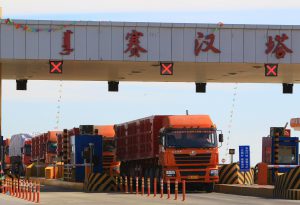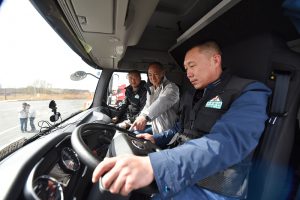Trucks are getting a lot of attention at the moment as companies like Tesla and Volvo race to design and manufacture battery-powered models with self-driving technology. But this hi-tech future of sleek, driverless trucks may be a while off yet.
In the meantime, companies can limit fuel usage, cut costs, and reduce carbon dioxide emissions and local air pollution through better aerodynamic design (using shapes that help objects move through air with less resistance). This technology can make a significant difference to fuel economy, is inexpensive, and ready for companies to use now.
Road freight is vital to the operations of many companies, transporting large volumes of goods within countries and internationally. Reducing emissions from the sector is crucial because road freight is a large global polluter, accounting for approximately 7% of energy-related CO2 emissions worldwide.
In China, the Guangdong Green Freight Demonstration Project has included pilot projects on various measures to improve fuel economy. These include tyres that reduce resistance and aerodynamic roof fairings (an additional part that can be attached to the roof of a truck to reduce drag).
Dr Fu Lu, director of Clean Air Asia China Office, noted that in the Guangdong demonstration, roof fairings delivered a good economic return at a low retrofit cost. She said that after spending US$374 (2,475 yuan) on each of its 12 trucks, one company saved almost US$100,000 (661,860 yuan) after five years.
And this means significant environmental benefits, too. “A pilot company which adopted roof fairings saved 25,343 litres of fuel per year and achieved 44 tonnes of CO2 reductions during demonstration, and it is estimated that emissions reductions for the company in five years would be 333 tonnes of CO2,” said Dr Fu Lu. That’s the equivalent of about 4.5 tankers of gasoline.
Promising dynamics
Aerodynamic designs range from inexpensive modifications that are retro-fitted to existing trucks, to brand new trailer designs that can make a big difference to large-scale road freight operations.
A lot depends on what suits local conditions. In the United Kingdom, for example, high average speeds for road freight mean aerodynamic designs can reap large benefits. In China, road freight generally travels slower and is heavier but tests of aerodynamic designs point to economic and environmental benefits.
Professor Holger Babinsky is an expert in aerodynamics at the University of Cambridge, who has worked on the design of road freight. His team’s research into aerodynamics has come up with surprising results: “So far, other people have looked at fairly big modifications with fairly big drag savings, and everybody thought that something minor was just cosmetic and would not actually achieve anything.”
“What we didn’t know before we started our project was that even relatively minor modifications actually have significant drag savings,” he said.
His team has shown that in the UK, where road freight produced 19.6 billion tonnes of greenhouse gas emissions in 2015, a new trailer design with a type of boat tail can cut carbon emissions by reducing fuel usage by as much as 7%.
This adaptation has no effect on the carrying capacity of the trailer, making it a viable cost-saving measure. The new design has since been adopted by Waitrose, a high-end British supermarket, which used the design in testing.
Professor Babinsky explained that by angling the back of the trailer a little bit by creating what’s called a “boat tail” the aerodynamic performance can be improved enormously.
“In the past, people have looked at very large boat tails, but they would be either something that sticks out of the back of the trailer, which is not legal [in the UK], or, if you bring the trailer in, you reduce volume, and if you can carry less, all the savings will be offset by the material you can’t transport.
“With Waitrose, we were able to find a compromise where the manufacturer was willing to change the way they make the backs of the trailer, especially the doors, so that we could incorporate a boat tail without changing the door size.
“You can still use exactly the same loading bay and load and unload just as quickly as before,” said Babinsky.
One reason such adaptations weren’t realised earlier is down to the nature of the road freight business. While companies like Volvo, which design tractors (the part of the truck with the engine and cabin) may have aerodynamic expertise and facilities, this has not necessarily been the case with the trailer designers.
More stringent standards
Given the benefits of aerodynamic designs, why aren’t more truck companies racing to adopt them? One reason is that governments haven’t told them to.
Ben Sharpe, a researcher on the heavy-duty vehicle programme at the International Council on Clean Transportation, pointed out that most countries, including China, favour rules that mandate particular levels of fuel efficiency, known as fuel consumption standards.
“Regulations are not mandating any specific type of technology, so the manufacturers are given free rein in choosing whatever types of design features will give them the certain level of performance that they need” said Sharpe.
“In the US market, virtually all of the companies are investing heavily in aerodynamics because it's a very cost-effective technology in this market,” he added.
In fact, the type of designs that are possible are less influenced by aerodynamics and more by road freight laws. For example, in the US, trucks have large noses because limits are placed only on trailer length whereas in Europe, the tractor is included too.
“So [manufacturers in Europe] make the towing configuration as short as possible, and they have to cram everything together and it makes it quite a bluff body, which is aerodynamically much harder to optimise,” said Babinsky.
The nature of the road freight industry is also important and can act as a barrier to widespread adoption, especially in China.
“Although investment in green freight technologies will be offset by fuel savings, the high initial investment is still prohibitive for most owner operators and small or medium-sized enterprises (SMEs). The freight sector in China is highly fragmented and logistics supply chains mainly consist of SMEs and owner operators,” said Dr Fu Lu.
Despite this, “ever-increasing fleets are realising the cost efficiency and rapid returns on investment associated with roof fairing devices. They are willing to retrofit their existing trucks. Roof fairing has been a prevalent practice in cities like Guangzhou and Shenzhen,” added Dr Fu Lu.
In the UK, the modified boat tail trailer created by Babinsky’s team is considerably more expensive than unmodified trailers. But after two years under typical industry conditions on the UK’s roads, the fuel savings comfortably pay for the improvement. The trailer is then expected to deliver savings for at least eight years.
This proven ability to cut costs and CO2 emissions means that freight aerodynamic designs look set to play an important role in the sector’s shift to a greener future.







